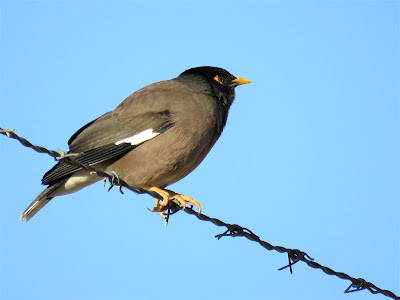The temperatures were well down on the norm for Saudi Arabia and I think this is the first time ever I had to wear a jumper while birding, although within an hour or so of dawn it was warming up nicely.
This area is a fairly popular picnic site for locals, although I have not seen many at the times I am there. They all tend to arrive in the evenings.
On each of the turrets that are spaced out along the wall of the Wadi were small flocks of Feral Pigeons. There are significant numbers of these around
Along with their cousins the Collared Dove and the Laughing Dove. These birds love to live in close proximity to city dwellers as the remnants of the picnics make for easy pickings.
Close behind the Pigeons and Doves are the Mynas' which also like the leftovers from our picnics.
The House Sparrow were present in good numbers, although not as many as I have seen here in the past.
and from time to time a few Spanish Sparrow appeared in the bushes.
One bird I have not seen in the area for quite some time is this Grey Hypocolius. On the day there were about 10 to 12 f them around the area in small groups
I did make several attempts to get a photo of the male birds to but they proved too quick and all the photos of those were blurred.
Our old friend the White Eared Bulbul were in most of the bushes and were busily feeding and I think pairing off, as I saw many getting together in pairs on branches.
However, there was also a pair of Spectacled Bulbul. So far I have seen a number of these at every site I have visited around Riyadh this year, in years gone by it was unusual to see one as they are more common in the south and west of the country. But maybe things are becoming more to their liking here in the Central Region.
One bird I have never come across in the Central Region before is this Ruppell's Weaver. These are fairly common in the south and west but not generally found here. Could this be a new development or simply a bird that has escaped from a cage somewhere?
In addition I flushed a Grey Heron early in the morning but it was still too dark to get a photo, later there was a Squacco Heron which also flushed. A number of Ring Necked Parakeets flew over screeching as they went and as we left the area I spotted a single White Crowned Wheatear.
See every day has its surprises even if it is a fairly short mornings walk!!
© Bernard Bracken






























